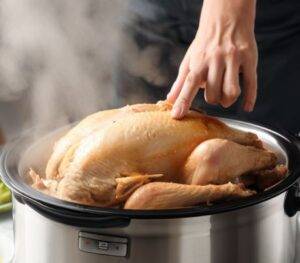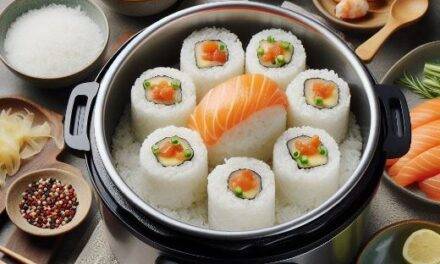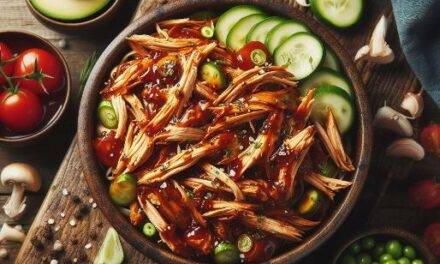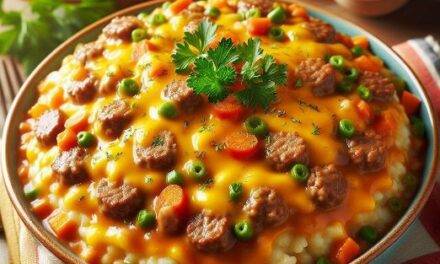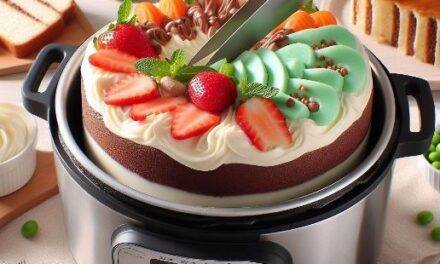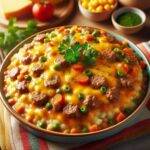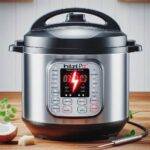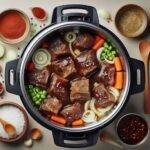Introduction:
How to cook chicken in pressure cooker, Are you tired of dry, flavorless chicken? Look no further! In this step-by-step guide, we will show you how to achieve perfectly pressure-cooked chicken every time. Whether you’re a novice in the kitchen or a seasoned pro, mastering the art of pressure cooking will completely revolutionize your culinary skills.
With the right techniques and a little bit of patience, you can create tender, juicy chicken dishes that will leave your taste buds begging for more. Not only is pressure cooking a quick and convenient method, but it also helps to lock in moisture and infuse flavors like never before.
From succulent whole roasted chickens to aromatic chicken curries, we’ve got you covered. Our comprehensive guide will walk you through every step, from choosing the right cuts of chicken to setting the pressure cooker and releasing the pressure safely. Get ready to impress your family and friends with your newfound expertise in pressure cooking chicken dishes. Now, let’s dive into the world of perfectly pressure-cooked chicken!
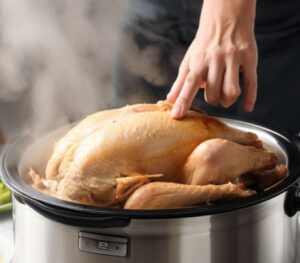
Why choose pressure cooking for chicken
Pressure cooking is a cooking method that involves using a sealed pot with steam pressure to cook food quickly. When it comes to chicken, pressure cooking offers several advantages over other cooking methods. First and foremost, pressure cooking helps to retain the natural moisture in the chicken, resulting in tender and juicy meat. Unlike traditional methods like baking or grilling, pressure cooking allows the chicken to cook in its own juices, enhancing the flavor and preventing it from drying out.
Additionally, pressure cooking is a time-saving technique. With the increased pressure inside the pot, the cooking time is significantly reduced. This makes it perfect for those busy weeknight dinners when you want a delicious and wholesome meal on the table in no time. The high pressure also helps to break down tough connective tissues in the chicken, resulting in meat that easily falls off the bone.
Lastly, pressure cooking is a versatile cooking method that allows you to experiment with a wide range of flavors and seasonings. Whether you prefer a classic roast chicken or a spicy chicken curry, the pressure cooker can handle it all. It’s a foolproof way to infuse your chicken with delicious flavors and aromas, making every dish a memorable one.
The benefits of pressure cooking chicken
Pressure cooking chicken offers a myriad of benefits that make it an attractive cooking method for any home cook. One of the key advantages is the ability to achieve consistent results every time. The sealed environment of the pressure cooker ensures that the chicken is cooked evenly, eliminating any chances of undercooked or overcooked portions. This is particularly important when it comes to poultry, as undercooked chicken can pose health risks.
In addition to consistent results, pressure cooking chicken also helps to preserve important nutrients. The high pressure and shorter cooking time help to retain more vitamins and minerals compared to traditional cooking methods. This means that you can enjoy a nutritious meal without compromising on taste or texture.
Another benefit of pressure cooking chicken is the convenience factor. Unlike other cooking methods that require constant monitoring and adjustment of heat, pressure cooking is hands-off once the pressure has been reached. This frees up your time to focus on other tasks or simply relax while your chicken cooks to perfection. It’s a great option for busy individuals or those who prefer a hassle-free cooking experience.
Choosing the right pressure cooker for chicken
When it comes to pressure cooking chicken, choosing the right pressure cooker is essential. There are two main types of pressure cookers available in the market: stovetop pressure cookers and electric pressure cookers. Each has its own advantages and considerations, so it’s important to choose the one that best suits your needs.
Stovetop pressure cookers are the traditional type of pressure cookers that are placed directly on a stove burner. They offer faster cooking times compared to electric pressure cookers and are generally more durable. Stovetop pressure cookers also tend to reach higher pressures, which can be beneficial for cooking certain types of chicken dishes.
On the other hand, electric pressure cookers are countertop appliances that are powered by electricity. They offer the convenience of set-it-and-forget-it cooking, with programmable settings and automatic pressure release features. Electric pressure cookers are generally easier to use, making them a popular choice for beginners or those who prefer a more hands-off approach to cooking.
Regardless of the type of pressure cooker you choose, there are a few key features to consider. Look for a pressure cooker with a sturdy construction and a reliable pressure release valve. Additionally, consider the size of the pressure cooker and whether it can accommodate the amount of chicken you typically cook. It’s always better to choose a slightly larger pressure cooker to avoid overcrowding, which can affect the cooking time and results.
Before you start pressure cooking your chicken, it’s important to properly prepare the meat. This involves selecting the right cuts of chicken, seasoning it appropriately, and ensuring it is at the ideal temperature before cooking.
When it comes to selecting the cuts of chicken, it’s important to choose ones that are suitable for pressure cooking. Ideally, opt for bone-in chicken pieces like drumsticks, thighs, or chicken breasts with the skin on. The bones and skin help to add flavor and moisture to the chicken, resulting in a more delicious end product. However, boneless chicken can also be used if that’s your preference.
To season the chicken, you can use a variety of spices and herbs to enhance the flavor. A simple mixture of salt, pepper, and garlic powder works well for a basic seasoning. However, feel free to experiment with different spices and seasonings based on your personal taste preferences. Whether you prefer a spicy kick or a fragrant blend of herbs, the choice is yours.
After seasoning the chicken, allow it to marinate for at least 30 minutes to allow the flavors to penetrate the meat. This step is optional but highly recommended for maximum flavor. Once the chicken is marinated, pat it dry with paper towels to remove any excess moisture. This will help to achieve a nice brown crust on the chicken during the pressure cooking process.
Lastly, ensure that the chicken is at room temperature before placing it in the pressure cooker. This helps to ensure even cooking and prevents the chicken from becoming dry. If the chicken is too cold, it may take longer to reach the desired temperature, resulting in overcooked meat.
Step-by-step guide to pressure cooking chicken
Now that you have prepared the chicken, it’s time to start pressure cooking. Follow this step-by-step guide for perfectly pressure-cooked chicken every time:
1. Heat the pressure cooker: Begin by heating the pressure cooker on the stove over medium heat. If you’re using an electric pressure cooker, select the sauté function and adjust the temperature accordingly.
2. Add oil: Once the pressure cooker is heated, add a small amount of oil. This will help to prevent the chicken from sticking to the bottom of the pot.
3. Brown the chicken: Carefully place the seasoned chicken pieces in the pressure cooker, skin side down. Allow them to brown for a few minutes until they develop a golden crust. This step helps to enhance the flavor and texture of the chicken.
4. Add liquid: After browning the chicken, add a small amount of liquid to the pressure cooker. This can be water, chicken broth, or any other flavorful liquid of your choice. The liquid will create steam, which is essential for the pressure cooking process.
5. Seal the pressure cooker: Close the pressure cooker lid securely, ensuring that the sealing ring is properly in place. If using a stovetop pressure cooker, ensure that the pressure regulator is set to the appropriate level.
6. Set the cooking time: Adjust the heat to maintain high pressure and set the cooking time according to the recipe or the type of chicken you’re cooking. The cooking time will vary depending on the size and cut of the chicken.
7. Cook under pressure: Once the cooking time is set, allow the pressure cooker to build up pressure. This can take a few minutes for stovetop pressure cookers and slightly longer for electric pressure cookers. Once the desired pressure is reached, the cooking time will start counting down.
8. Release the pressure: After the cooking time is complete, it’s time to release the pressure. There are two methods for releasing the pressure: natural release and quick release. Natural release involves allowing the pressure to come down naturally, which can take anywhere from 10 to 20 minutes. Quick release involves manually venting the pressure using the pressure release valve. Be sure to follow the manufacturer’s instructions for your specific pressure cooker.
9. Check the chicken’s internal temperature: Once the pressure is fully released, carefully open the pressure cooker lid. Use a meat thermometer to check the internal temperature of the chicken. For safe consumption, the chicken should reach an internal temperature of 165°F (74°C).
10. Rest the chicken: After removing the chicken from the pressure cooker, allow it to rest for a few minutes before serving. This helps to redistribute the juices, resulting in a more flavorful and tender end product.
With this step-by-step guide, you’ll be able to pressure cook chicken with confidence and achieve delicious results every time.
Step-by-Step Table Guide to Cooking Chicken in a Pressure Cooker:
| Step | Description |
|---|---|
| 1 | Rinse the chicken and pat it dry. |
| 2 | Add the chicken, broth, salt, and pepper to the pressure cooker. |
| 3 | Close the lid and seal the pressure cooker. |
| 4 | Cook on high pressure for 10 minutes for boneless, skinless chicken breasts, or 15 minutes for boneless, skinless chicken thighs. |
| 5 | Let the pressure release naturally for 10 minutes, then quick release any remaining pressure. |
| 6 | Shred the chicken with two forks and serve. |
Recipe Ideas:
Now that you’ve mastered the basics, here are a few delicious chicken recipes you can try in your pressure cooker:
1. Chicken and Rice: Add rice, broth, and your favorite seasonings to create a one-pot chicken and rice dish.
2. Chicken Curry: Prepare a flavorful curry by adding coconut milk, curry paste, and vegetables to your pressure cooker.
3. BBQ Pulled Chicken: Cook chicken with BBQ sauce for tender and savory pulled chicken sandwiches.
4. Chicken Soup: Make a comforting chicken soup with chicken, vegetables, and broth.
Conclusion:
Cooking chicken in a pressure cooker is a convenient and efficient way to prepare delicious meals in less time. With the right equipment, proper preparation, and a variety of recipes at your disposal, you can enjoy tender, flavorful chicken dishes that will impress your family and friends. So, don’t hesitate to try these techniques and recipes, and elevate your chicken cooking game with the power of a pressure cooker! and for more recipe ideas click here.

